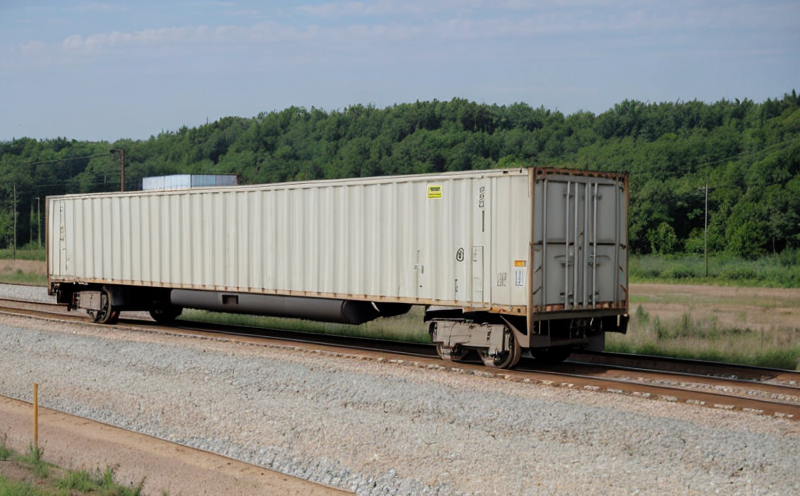EN 50125 Climatic Testing of Freight Wagon Equipment
The EN 50125 standard is a crucial document in railway and transportation testing, particularly focusing on the climatic conditions that freight wagons must endure during their operational lifecycle. This European standard ensures that all electrical equipment used in passenger and freight vehicles complies with environmental requirements necessary for safe and reliable operation.
The EN 50125 specifies a series of tests designed to evaluate how electrical and electronic components perform under extreme climatic conditions, such as high temperatures, low temperatures, humidity, rain, and sandstorms. These tests are essential in ensuring that equipment functions reliably in harsh environments encountered during transportation.
For freight wagons, this testing is critical because these vehicles traverse diverse geographical regions with varying climates. Ensuring that the electrical systems within these wagons meet EN 50125 standards guarantees their resilience and reliability, which are paramount for maintaining safety and efficiency in railway operations.
The testing process involves subjecting equipment to a series of environmental conditions that simulate real-world climatic challenges. This includes exposure to temperatures ranging from -40°C to +80°C, humidity levels up to 95% relative humidity, and the application of salt spray and sand for abrasion resistance tests.
During these tests, specimens are placed in a controlled environment that can simulate extreme climatic conditions. The testing apparatus is designed to replicate harsh environmental factors accurately, ensuring that any defects or vulnerabilities in the equipment are identified before deployment in operational settings.
The EN 50125 standard also emphasizes the importance of durability and reliability by requiring repeated cycles of temperature changes, humidity variations, and other stressors. This ensures that the equipment can withstand long-term exposure to adverse conditions without failing.
Compliance with EN 50125 is not just a technical requirement but a critical factor in maintaining the integrity of railway operations. By ensuring that electrical and electronic components meet these stringent standards, rail operators can trust that their equipment will perform reliably under all climatic conditions, thereby enhancing overall safety and operational efficiency.
Key Test Parameters
- Climatic Cycles: Temperature changes from -40°C to +80°C with precise control over humidity levels up to 95% RH.
- Salt Spray Testing: Exposure to salt spray for assessing corrosion resistance.
- Sand Abrasion Tests: Evaluation of abrasion resistance against sand particles simulating dusty environments.
Specimen Preparation
To ensure accurate testing, specimens must be prepared according to the specified guidelines in EN 50125. This includes cleaning and degreasing components before placement into the environmental chamber for testing. Ensuring that all parts are free from contamination is crucial for obtaining reliable test results.
Instrumentation
The testing process relies on sophisticated instrumentation to monitor and control environmental conditions accurately. This includes temperature sensors, humidity meters, and climate-controlled chambers capable of replicating extreme weather conditions. Advanced data logging systems are used to record temperature changes, humidity levels, and other parameters throughout the test duration.
Reporting
A comprehensive report detailing the results of each climatic test is essential for compliance purposes. This report should include detailed descriptions of the environmental conditions applied during testing, the performance of the equipment under these conditions, and any anomalies observed. Compliance with EN 50125 not only ensures regulatory adherence but also enhances trust in the reliability of railway equipment.
International Acceptance and Recognition
- European Union: EN 50125 is widely recognized across EU member states, ensuring uniform standards for railway operations.
- Eurasian Economic Union (EEU): The standard is accepted within the EEU framework, facilitating seamless cross-border transportation and compliance.
The international recognition of EN 50125 underscores its importance in ensuring consistent quality across different railway systems. Compliance with this standard is not only a requirement for European operations but also extends to global markets where stringent environmental standards are necessary.
By adhering to the requirements outlined in EN 50125, manufacturers and operators can ensure that their equipment meets the highest international standards, thereby enhancing operational reliability and safety. This recognition also facilitates smoother regulatory processes and reduces the risk of non-compliance penalties.
Environmental and Sustainability Contributions
The EN 50125 standard plays a pivotal role in promoting environmental sustainability within railway operations. By ensuring that electrical equipment is robust enough to withstand extreme climatic conditions, this standard reduces the need for frequent maintenance and replacements, thus minimizing waste.
Moreover, the testing process itself contributes to sustainable practices by identifying defects early on, preventing the deployment of substandard components in operational settings. This proactive approach not only enhances reliability but also helps reduce energy consumption and carbon emissions associated with less efficient equipment.
The durability and longevity ensured by EN 50125 contribute significantly to reducing the environmental footprint of railway operations. By extending the lifespan of equipment, this standard supports a more sustainable approach to transportation infrastructure development.
Competitive Advantage and Market Impact
- Enhanced Reliability: Compliance with EN 50125 provides a competitive edge by ensuring that equipment can withstand harsh environmental conditions, thereby enhancing reliability.
- Customer Trust: Meeting international standards like EN 50125 builds trust among customers and stakeholders, leading to increased market share and customer loyalty.
The competitive advantage provided by compliance with EN 50125 is significant. It not only ensures that equipment meets stringent environmental requirements but also positions companies as leaders in railway safety and reliability. This can lead to a higher demand for products from compliant manufacturers, thereby enhancing market competitiveness.
From an operational perspective, the enhanced reliability of equipment means fewer disruptions due to failures or malfunctions. This translates into improved service levels and customer satisfaction, further boosting a company's reputation and market position.





